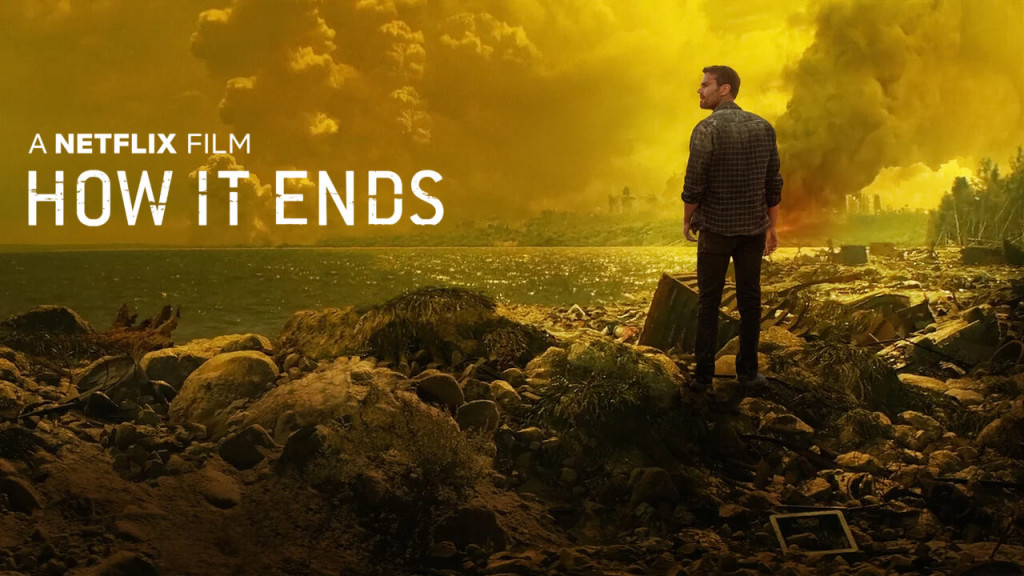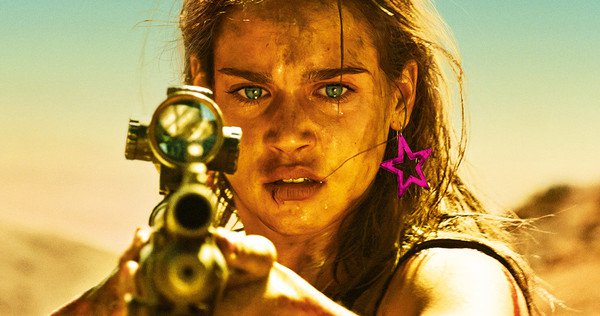Today I take a look at one of my Top 25! scripts and how it translated to the Netflix screen.
Genre: Action/Thriller
Premise: (from IMDB) When a mysterious disaster turns the country into a war zone, a young lawyer heads west with his future father-in-law to find his pregnant fiancée.
About: How It Ends shot into my Top 25 back in 2011. Since then, it’s gone through many “almosts” in getting made. It took the determination of the Netflix machine to change the project’s fortunes. The film debuted this weekend on the streamer. It stars Theo James (The Hunger Games) and Forest Whitaker. It was directed by David Rosenthal, whose previous credits include The Perfect Guy and A Single Shot. Brooks McLaren was an unknown writer when his script made The Black List back in 2011. He’s currently working on the “Rambo: New Blood” script.
Writer: Brooks McLaren
Details: 113 minutes
Some of you may remember this script from a looooong time ago. I read it and instantly fell in love with it, enough to clear room in my Top 25. Finally, after seven long years, the movie’s been made. And thank goodness for Netflix. I have no doubt How it Ends wouldn’t have seen the light of day without the service.
I may have issues with Netflix. But you have to love the fact that they’ve single-handedly brought back the mid-budget film. They don’t make these movies for theaters anymore. Especially if they don’t have a marketable genre component to them – like zombies. Every time I dog Netflix, I have to remind myself of that.
For those who don’t remember, How it Ends is about a lawyer, Will Younger, who’s on a business trip in Chicago, talking with his fiancé back in Seattle on Skype, when all of a sudden a loud banging noise occurs off-screen. Scared, his fiancé says she needs to check it out and then – FWIP – the feed cuts out. And it’s not just the Skype feed. All feeds from the West Coast cut out. Nobody knows what’s going on over there.
It just so happens that Will’s fiancé’s dad, Tom, lives in Chicago. Will’s been avoiding Tom because Tom doesn’t like him. But he has to see him now. As the West Coast situation worsens, Tom and Will decide to drive to California to get to the fiancé. Along the way, their car breaks down near a Native American reservation, and they’re forced to ask for help from a young Native American woman, who ends up coming with them. However, the closer they get to the coast, the more chaotic the world gets. Will they be able to overcome these odds and get to Seattle in time???
Before I get into the script stuff, I’m going to say some things that are going to make it sound like I’m making excuses for a script that some people thought was never that good in the first place. And I’m okay with that. Because I know I’m right. :)
Never has it been so apparent how much a movie suffers when it doesn’t have a good director. This film was terribly directed. For starters, the cinematography was awful. Every shot had the background blown out and the actor’s faces in darkness, making it impossible for me to see basic things like facial expressions.
But the silent killer was the sound design. The entire movie was done through ADR. ADR (additional dialogue recording) can work as a patch. The problem with doing it the whole movie is that nobody sounds real. The voices are too smooth, too calm. And the reason they’re too smooth and too calm is because the actors are in a quiet comfortable booth recording their lines. In addition to there being a disconnect between the true performance and the more relaxed audio performance, the audio quality is too slick and too clean to not draw attention to itself.
I can’t convey enough how much this pulled me out of the movie. It was like watching one long lip-sync.
There were other problems with the direction as well, such as the fact that the night-time car scenes looked like they were shot on an iphone with a 3-point Lowell lighting kit from BP Photo. And I get it. This movie doesn’t have a huge budget. But part of your job as a director is to make stuff look better than the budget you’ve been given. Can you imagine what Coralie Fargeat would’ve done with a movie like this? Her film looked amazing and it was shot for a lot less than this one.
I read How it Ends at a time when I was in full GSU mode (Goal, stakes, urgency). It was one of the best embodiments of the formula I’d read up to that point. We’ve got a clear goal – get to the fiancé. Clear stakes – if we don’t, she dies. Clear urgency – Every passing moment society is falling more and more apart.
On top of that, we have a turbo-boost to the GSU formula: a giant mystery at the center of the film. What’s happened that’s causing all of this? Even if you’re not totally invested in the pursuit itself, you can’t help but wonder what’s going on.
On top of THIS, you’ve got a central character pairing that’s packed with conflict – the dad who doesn’t think the fiancé is good enough for his daughter. When you’re sending a character out on a long journey, you need a way to build drama into each scene. Stuffing two characters who don’t see eye-to-eye into a tight space for two hours is guaranteed drama.
All of these things were in the script yet I felt none of them onscreen.
Why?
That’s hard to figure out. I’d begin with the situation itself. In the script, the implosion of society and threat of an unseen menace was way more intense. Whereas in the script, things were ramped up to a 9. In the film, they were around a 5 or a 6. Wherever they went, things seemed calm. There weren’t a lot of crazies running around. You were convinced they could handle any problem.
For example, there were two major roadblocks early in the film. And they were able to get through simply by asking. In screenplays, you gotta make everything tough for your hero. Especially in a movie like this, where the world is falling apart. This idea is built for making things tough.
Then, later, in the one roadblock scene that wasn’t easy – a bridge they needed to cross – they turned it into this really cheesy Karate Kid scene with a couple of guys on dirt bikes who chased after our heroes. You gotta WIN each scene as a filmmaker. And in three of the biggest scenes, they lost.
Then there were little problems that added up. Such as the fact this entire icy relationship between the father and the fiancé-in-law is built on the idea that the son isn’t good enough for his daughter. Yet the son was a) strong and chiseled out of stone, an ideal protector, b) smart, c) presentable, and d) had a good job. This is the kind of man any normal father would be ecstatic his daughter was marrying. Yet we happened to have the one dad who didn’t like him.
Why is this an issue? Because when there’s a disconnect between what the audience is seeing and what the father is seeing, it feels like the only reason the father is acting that way is because the writer needs him to to act that way for his story to work. They could’ve solved this by casting someone who looked more like the kind of person a father didn’t think deserved his daughter. A Shia LaBeouf type, for example. Untamed, rough around the edges, a wild card.
And there were these tonal missteps. At one point, the group gets to an abandoned water park and the Native American girl jumps out of the car with a giant smile on her face and leaps into the pool, laughing excitedly at the chance to cool off. It was supposed to be the scene equivalent of a drink. Something to take the edge off after a long day.
Except that in every scene up to that point, Native American Girl had been the most dire, sad, miserable, human being in the world. The act disobeyed the very essence of her character make-up. You can’t just change who people are to fit a scene. You have to stay consistent. And the irony is, the movie could’ve used a sense of humor. It would’ve been smart to have more scenes where the characters were laughing so as to break up the enormously intense heaviness that permeated the movie.
I always try to remind writers that. The reader can’t appreciate the bitter unless they get the sweet. And vice versa. You can’t go crazy of course. You shouldn’t be putting Anchorman scenes in a movie like this. But you need the occasional bright spot if only to jolt the reader out of their malaise.
I’m not sure how to categorize this one. It’s on Netflix so it won’t cost you any money. So is it worth a free watch? I suppose it is if you’re doing background watching. But if you’re setting aside time just to watch a movie, you’ll probably be bored.
[ ] What the hell did I just watch?
[x] wasn’t for me
[ ] worth your time on Netflix
[ ] impressive
[ ] genius
What I learned: As much as it pains me to say this, movies like this struggle to get made because they don’t have a clear monstrous presence that can be marketed. In other words, there are no aliens. There are no zombies. There are no monsters. When audiences see trailers like this, it’s confusing for them. Because they ask, “Where’s the threat?” The threat, of course, is us (humanity). But people who just want to watch a fun movie don’t see it that way. They see a hole that hasn’t been filled. Anyone who watched this probably left saying, “That’s it?” The reason is the lack of that marketable element.



